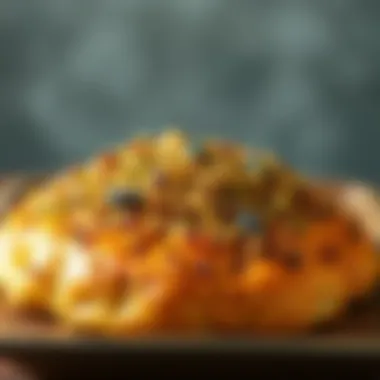Discovering Manakish: A Culinary Delight in Dubai


Intro
When one strolls through the vibrant streets of Dubai, an array of flavors waft through the air, igniting culinary curiosity. Among these, manakish stands out as a loved traditional flatbread, a true gem in Dubai’s rich food culture. This savory treat can best be described as a canvas, ready to be painted with an assortment of toppings, from the classic za'atar blend to hearty cheese and beyond. It’s not just a meal; it’s a ritual, a part of daily life for many locals and a must-try for tourists.
Manakish is not just food, it resonates with stories of generations, making it a dish that encapsulates the essence of Middle Eastern culture. Over the years, manakish has transcended its humble roots, carving out a significant place in the culinary landscape of Dubai. It effortlessly bridges the gap between tradition and modernity, beloved by both the old and the young. This exploration aims to peel back the layers of this delicious flatbread, shedding light on its history, intricacies, and places to savor it, thus giving readers an enriched understanding of this culinary delight.
In the following sections, we will dig deeper into its historical significance, diverse toppings, and the prime locations where one can taste authentic manakish. The discussion will also reflect on how this flatbread represents the heart of local dining culture and community gatherings. Prepare to embark on a journey through flavors and traditions that define manakish in the ever-growing metropolis of Dubai.
The Origins of Manakish
The origins of manakish are integral to understanding its cultural and culinary significance, particularly in the vibrant landscape of Dubai. This traditional flatbread is not just a dish; it embodies centuries of history, melding the influences of various cultures that have intersected in the Middle East. Exploring the roots of manakish enables us to appreciate not only its flavors but also the stories woven into its preparation and consumption.
Historical Context
The timeline of manakish stretches beyond mere culinary fabric; it is a reflection of the region’s rich history. While specific records are scant, the origins of manakish are often traced back to the Levant region, perhaps as far as the early Islamic period. Nomadic tribes used to have simple flatbreads, which evolved as cultures blended through trade routes. Over the centuries, these flatbreads became a beloved staple, adapted with local ingredients and toppings.
In medieval times, manakish gained prominence in various cities, often served in communal settings. Archaeological findings in places like Jordan and Lebanon indicate that ancient preparations were both an art and a necessity. Each layer of manakish tells a tale of the ingredients—be it the finely milled wheat, the fragrant herbs, or the sizzling oils used in cooking.
Cultural Significance in Middle Eastern Cuisine
Manakish carries a weight of cultural importance in Middle Eastern cuisine, serving as a cohesive element in communal meals and family gatherings. In many households, the dough is rolled out and topped with spices, then shared among family members, fostering a sense of togetherness. It's commonplace to see manakish being enjoyed at breakfast, where its warm, inviting scent fills the home.
Moreover, this flatbread transcends beyond mere sustenance. It’s often accompanied by unique and locally sourced products, like labneh or olives, turning a simple meal into a culinary experience.
From Beirut to Dubai, manakish has adapted and thrived, influenced by local tastes while retaining its authentic roots. Today, its popularity has spread far and wide, appealing to both locals and tourists who seek to relish an authentic taste of the Middle East.
"Manakish isn’t just food; it's a tradition shared, a flavor celebrated, and a story told with every bite."
As we dive deeper into the world of manakish, its origins will lay the groundwork for appreciating its various forms and the processes that bring this beloved dish to life.
Understanding Manakish
Grasping the concept of manakish offers more than just an insight into a popular Middle Eastern dish; it's a window into the heart of Dubai’s vibrant culinary scene. Manakish represents not only a delicious food item but also serves as a symbol of the cultural fusion that defines modern Dubai. Understanding this delicacy allows one to appreciate its roles in various social settings and its significance in daily life for both locals and visitors alike.
What is Manakish?
Manakish is essentially a flatbread, often likened to pizza but with its own unique flavor profile. Originating from the Levant region, this dish consists of dough that is topped with an array of ingredients before being baked in a hot oven. The most common variant features za'atar—a spice blend that adds depth and a distinct tang to the bread. The blend of warmth from the baked dough with the aromatic toppings makes manakish a truly delightful culinary experience. Not just a meal, it can be a part of various rituals, ranging from breakfast with family to a late-night snack in bustling street markets.
Common Ingredients
The heart of any dish lies in its ingredients, and manakish is no different. Key components include the dough itself and the various toppings that can transform it from a simple bread to a savory delight.


Flour and Dough Preparation
The foundation of manakish starts with the wheat flour, typically all-purpose or bread flour, which offers the right balance of strength and elasticity. This choice contributes to the dough's chewy texture. The preparation process involves mixing flour with water, yeast, and sometimes a dash of salt, allowing it to rise to perfection.
Crucially, the way the dough is worked—kneading it until smooth—ensures that it can hold the generous toppings without tearing. The slight variation in preparation methods, whether by hand or using machinery, can lead to subtly different textures, inviting personal preference into the mix. This contributes to the allure of manakish, as each vendor or home chef may have their own unique twist on the dough-making process.
Common Spices and Toppings
Toppings make manakish come alive. The most common choice is za'atar, a potent blend typically made of dried thyme, sumac, and sesame seeds. It carries a herby, nutty flavor that elevates the eatery experience. Other frequent options include cheese, particularly akkawi, which melts beautifully, providing a creamy contrast to the bread's base.
Interestingly, different regions play with toppings, adding ingredients such as spiced minced meat or vegetables, reflecting local tastes and customs. This versatility of manakish makes it appealing to all kinds of eaters—whether you have a sweet tooth or prefer something savory. However, while some toppings may please the palate, they can also vary in availability depending on the season or vendor, adding an element of surprise each time one orders this dish.
"Manakish isn't just food; it's a slice of culture. Every bite tells a story about the people who create and enjoy it."
Understanding manakish means not just knowing its ingredients but also appreciating the cultural significance behind it. The diversity in preparation and the customary features of toppings highlight its role as a beloved staple in Dubai and beyond.
Popular Varieties of Manakish in Dubai
When we talk about manakish in Dubai, it’s not just about a single flatbread; it’s about variety and flair. Each type tells its own story and showcases the creativity of local culinary artists. For anyone looking to experience Dubai’s rich food scene, understanding the popular varieties of manakish is essential. From the intriguing flavors that tempt the taste buds to the social aspects tied to each, these flatbreads embody the vibrant culture of the UAE.
Za'atar Manakish
Za'atar manakish is often considered the face of this delightful flatbread in Dubai. This variety is topped with a blend of za'atar spice, which typically includes thyme, sesame seeds, and sumac. The aroma alone can be enough to captivate those wandering the bustling streets of the city. The flavors are robust yet balanced, making it a favorite breakfast choice among locals.
You can find za'atar manakish at many bakeries, each infusing their own twist on the traditional recipe. Some even incorporate a drizzle of olive oil or a sprinkle of cheese on top to elevate the experience further. For many, it transcends mere food; it represents mornings spent in pleasant company, mingling over hot, freshly baked bread.
Cheese Manakish
Another variant that garners significant attention is cheese manakish. This style is a dream for cheese lovers. Often made with a blend of white cheeses, it creates a gooey, rich texture that contrasts beautifully with the crispiness of the flatbread. Whether you prefer it with just cheese or mixed with herbs and spices, it’s always a hit.
Many locals enjoy cheese manakish as a snack or light meal. It pairs exceptionally well with yogurt or pickles, providing a delightful balance of flavors and textures. For tourists, indulging in cheese manakish can be a gateway into discovering other Middle Eastern cuisines, as it showcases the region's penchant for rich, flavorful pairings.
Meat-Topped Manakish
Meat-topped manakish brings a heartier option to the table. Typically featuring either minced lamb or beef, this variety is usually seasoned with a medley of spices, creating a savory punch that’s hard to resist. It serves as a fulfilling meal, perfect for an on-the-go lifestyle or a late-night snack.
The meat is often complemented by toppings like pine nuts or herbs, giving it both texture and depth. Like other varieties, this type of manakish is widely available across various eateries. Each restaurant’s secret seasoning might add a new twist, making it a delightful adventure for those wanting to explore Dubai’s culinary landscape.
In summary, the sheer diversity of manakish varieties in Dubai is what makes them so appealing. They are not just simple flatbreads; they are culinary expressions that reflect the rich history and modern innovations of Dubai's food scene. The next time you find yourself in the city, don’t just settle for one; taste them all, and take in the unique stories that each bite delivers.
The Art of Preparing Manakish
The preparation of manakish is not just about following a recipe; it's a delicate interplay of tradition, technique, and taste. Understanding this art forms the heart of our exploration into manakish's role in both local and broader culinary landscapes. The methods used to craft this beloved dish showcase the blend of historical roots and modern twists that characterize Dubai's food scene. This section delves into the two vital components of preparing manakish: traditional methods and modern adaptations.


Traditional Methods
When it comes to making manakish, traditional methods play a pivotal role, ensuring that each bite reflects a deep culinary heritage. The process begins with high-quality ingredients: flour, yeast, water, and a dash of salt. This fundamental mixture forms the dough, which is then allowed to rise in a warm environment, signifying that patience is integral to the craft.
Once the dough has risen to perfection, it's rolled out thinly. This step requires skill; it must not be too thick or too thin, as the texture is crucial in achieving that sought-after balance of crispiness and chewiness. Bakers, especially in local kitchens, often rely on their intuition rather than strict measurements, which adds a personal touch.
Toppings like za'atar or cheese are then generously spread upon the flatbread before being placed in a wood-fired oven. The high temperatures of such ovens impart a unique flavor that gas or electric models simply cannot replicate. The results are savory and aromatic, paying homage to age-old practices passed down through generations.
Modern Adaptations
As tastes evolve, so does the art of making manakish. In Dubai, modern adaptations reflect the diverse culinary influences that have permeated the city. Chefs now look beyond traditional toppings, experimenting with ingredients and flavors that cater to a wider audience. For instance, you might find manakish adorned with gourmet toppings like smoked salmon, avocado, or even truffle oil.
The preparation process has also seen technological enhancements. Many restaurants have adopted high-tech ovens which can replicate those ideal wood-fired conditions without the hassle of firewood. This innovation not only increases efficiency but also ensures consistent quality.
Furthermore, local food festivals often feature fusion manakish, where traditional flavors amalgamate with international cuisines. For example, a spicy Italian-style manakish topped with mozzarella and roasted tomatoes can attract curious foodies and locals alike.
Each method, whether traditional or modern, offers its distinct charm and flavor profile, enriching the culinary repertoire of Dubai and showcasing manakish's versatility.
"Manakish is more than food; it's a connection to our past, reimagined for the present."
Culinary Experiences in Dubai
Culinary experiences in Dubai benefit both residents and tourists, embracing the city's diverse food culture. The spotlight on manakish showcases not just a delicacy but also reflects Dubai's rich culinary heritage. While fine dining captures the heart of luxury, its casual flares, like street vendors selling manakish, become an essential experience for anyone seeking the authentic taste of the region. Understanding these experiences helps illuminate the nuances of Dubai's evolving culinary landscape.
Top Restaurants for Manakish
Local Favorites
When it comes to local favorites, the talk usually circles back to places like Al Mallah, where manakish isn't just a meal—it's a ritual. The crispy texture and aromatic flavors here invite both locals and curious newcomers. The key characteristic of Al Mallah lies in its ability to balance tradition with a modern setting, creating an ambiance where history marries today’s casual dining. The advantage in choosing such places isn't merely the food; it’s the story that comes with each bite. While it can be bustling and loud, this adds to the experience, making it communal and lively.
Tourist Hotspots
For those new to the city, tourist hotspots like Sheikh Zayed Road offer an accessible way to enjoy manakish while soaking in the vibrant atmosphere. Restaurants such as Zaatar w Zeit are designed with a flair that appeals to a broad audience. Here, the inviting decor and extensive menus often leave a lasting impact. The major advantage is variety—laminated menus with enticing visuals can cater to an array of palates. But there might be a pinch of compromise on authenticity, as these locations tend to focus on presentation and atmosphere.
Street Food Culture and Manakish
Street food in Dubai breathes life into the city’s culinary scene. Manakish, with its simplicity, manages to appeal to a crowd eager for quick bites yet full flavors. Street vendors, often seen in bustling markets, adeptly prepare this flatbread using traditional techniques, ensuring that every fold and topping reflects genuine care. This culture of ease and accessibility creates a bond amongst consumers, where each bite shared speaks volumes of everyday life in Dubai—a little spice of tradition wrapped in a flatbread, showcasing culinary cultural convergence.
"Manakish is not just food; it’s a shared tradition that brings people together, speaking of home and heritage on each plate."
In summary, exploring the local favorites, tourist hotspots, and street food scene around manakish provides a comprehensive look into the culinary experiences quickening the pulse of Dubai's food landscape. This vibrant interplay of flavor, culture, and community underscores why manakish is a must-try for anyone visiting or residing in this remarkable city.


Manakish: A Meal for Every Occasion
Manakish holds a significant place in Dubai's culinary landscape due to its versatility and appeal for various meals throughout the day. This flatbread, originating from Middle Eastern roots, has transformed into a beloved dish for locals and tourists alike, creating a bridge between traditional flavors and contemporary dining experiences. Its ability to adapt to different contexts makes it more than just a meal; it is a cultural symbol reflecting the everyday life of those in Dubai. Additionally, the variety of toppings and preparation styles contributes to its popularity, making it suitable for many occasions.
Breakfast Staple
Starting the day with manakish is not only a common practice but also a cherished one in many households across Dubai. A typical breakfast might feature fresh za'atar manakish, often paired with a cup of thick, rich Arabic coffee. The aroma of baked dough mingling with olive oil and spices is a delightful morning ritual that many families eagerly anticipate.
In many street stalls, you can find a wide array of options. Vendors typically prepare fresh batches throughout the morning, ensuring that customers enjoy their meal while still warm. The combination of crispy edges and a fluffy center creates a comforting way to kick off the day. Those seeking a heartier option might enjoy a cheese manakish, rich with melted cheese that satisfies even the most voracious appetites first thing in the morning.
Snack for a Quick Bite
In a city that never sleeps, manakish also serves as an ideal snack for those on the go. Whether it's during a lunch break or an afternoon craving, a quick stop at a local shop provides an efficient solution. Vendors keep their counters filled with an assortment of manakish, offering a quick satisfaction for anyone with a rumbling stomach.
Spices and toppings play a vital role here. The simplicity of the plain dough topped with za'atar offers a light yet flavorful option for a snack that won't weigh you down. It's just enough to take the edge off without being overly filling. This aspect makes manakish a daily staple in many lives.
Party Favorite
When it comes to gatherings and celebrations, manakish shines as a popular choice. It is more than just a dish; it often represents hospitality and warmth. At social events, it is common to see trays filled with assorted manakish, inviting guests to sample a variety of flavors and styles. A meat-topped manakish adorned with minced lamb or beef provides a hearty option that can easily serve as a main dish at parties.
Its finger-food appeal garners it a special place at gatherings. Guests can munch on it while mingling, making it a convenient choice for both hosts and attendees.
In summary, manakish transcends being just a meal; its presence resonates during breakfast, as a snack, and as a party favorite. The adaptability of this flatbread, coupled with its ability to embody the spirit of Middle Eastern hospitality, contributes to its enduring popularity in Dubai's vibrant culinary scene.
"Manakish is more than food; it's a slice of life—warm, inviting, and rich with history."
For further reading on the culinary significance of manakish, visit en.wikipedia.org or explore discussions on reddit.com about local favorites.
Ending: The Legacy of Manakish
Manakish stands as much more than just a staple of Middle Eastern cuisine; it embodies the rich tapestry of tradition, culture, and community that characterizes Dubai's culinary landscape. The legacy of manakish is shaped by its historical roots, the common thread of activities surrounding its preparation and consumption, and the way it has seamlessly integrated into the daily lives of both locals and visitors. It's not just a food item; it is a narrative, a piece of the city's identity, and a bridge linking generations and cultures.
Culinary Impact on Dubai’s Food Scene
The influence of manakish extends far beyond its delicious taste; it represents an evolution of Dubai’s food scene. Originally, it served as a humble flatbread, but over time, manakish has adapted and transformed, reflecting the diverse and cosmopolitan nature of the city.
- Local Staples: The traditional manakish is often a go-to meal for breakfast, making it a household favorite. Its versatility allows it to cater to the palate of various demographics, be it families enjoying a weekend breakfast or young professionals grabbing a quick bite between meetings.
- Crossover with Global Trends: In recent years, there’s been a notable rise in gourmet manakish. Influential chefs began to experiment with unconventional toppings, merging international flavors with the traditional base. This has opened the floodgates for various culinary innovations, drawing in a mixed crowd of food lovers eager to explore.
Interestingly, many restaurants in Dubai have made it their mission to perfect manakish, using artisanal methods for dough making and a variety of fresh toppings, thus elevating what was once street food into an artisan experience. This has not only contributed to the local economy but has also positioned Dubai as a culinary hub on the international stage.
Future of Manakish in Modern Cuisine
Looking toward the future, the charm of manakish isn’t likely to fade. In fact, it is poised to undergo further evolution, guided by sustainability trends and the increasing importance of health-conscious dining.
- Healthier Options: We’re already seeing variations made with whole grain flours, vegan cheese, and organic toppings, catering to a society that is more aware of nutritional choices. As a staple that can be easily adapted, the possibilities for refinement are nearly endless.
- Globalization of Flavors: With globalization, the introduction of different cultural influences into the manakish framework is also probable. We'll likely see more fusion styles that incorporate flavors and ingredients from around the globe, giving rise to a new variety of manakish that tells stories from various culinary traditions.
- Community Initiatives: There’s a growing movement among food enthusiasts to bring manakish-making classes to both locals and tourists. These experiences foster community, creating a deeper appreciation for this dish while also rooting it firmly in the culinary practices of future generations.
"Manakish is a reflection of our convolution, where history blends with modern desires and future potentials. It’s a dialogue between the old and the new, inviting all to take part in its ongoing story."
In summary, manakish will likely continue to hold its ground in the rich food scene of Dubai. The dish offers a canvas where cultural narratives intertwine, ensuring its legacy will remain vibrant for years to come.











